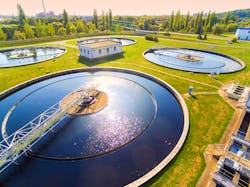The substantial energy efficiency and performance gains of using variable speed drives (VSDs) to control the vast number of electric motors, pumps and fans used in the water industry are well documented. A somewhat lesser-known fact is that VSDs and many other types of non-linear loads, such as EC (electronically commutated) motors, LED or fluorescent lighting, computers, uninterruptible power supplies (UPS), and Wi-Fi routers, can cause an undesirable event known as harmonic distortion in the electrical network.
Harmonics can cause damage to sensitive electronic equipment, interference in communication equipment, and false readings on measurement devices. They can trip circuit breakers, blow fuses, and damage capacitors, or contribute to the overheating of transformers, cables, motors, generators, and capacitors, wasting energy and shortening the lifespan of this equipment.
Therefore, while the benefits of VSDs far outweigh the effects of harmonics, it is essential to understand the problems that harmonics can cause — and the solutions available to eliminate them.
Harmonics Explained
In a perfect world, the alternating current (AC) in an electrical grid presents as a pure sinusoidal wave, running at a base frequency of 50 or 60 Hertz (Hz). In reality, the use of non-linear loads creates harmonics — multiples of the base frequency — that cause significant deviations from this pure sine wave in both the current and voltage. The resulting distortion, or electronic pollution, means that energy is lost within the network rather than used by the equipment it serves.
While a single 4-kilowatt (kW) drive, even with 100 percent THDi, is unlikely to cause issues, multiple drives will have a cumulative effect as the excess current produces more heat. Not only does this heat waste energy, but overheating makes equipment more unreliable and shortens its life expectancy.
These issues can have a substantial financial impact during all phases of an installation’s lifespan. System inefficiency adds to daily running costs, while premature equipment failure carries unnecessary repair and replacement costs. When selecting equipment, it is crucial to ensure it does not have an adverse effect on the power system or connected devices.
A Modern Solution to Harmonics
A common mitigation technique to address the troublesome effect of harmonics is to oversize power components or cables to deal with overheating. For example, the incoming transformer may have to be a higher rating, for which the local power utility will charge higher fees. Many local power companies require operators in water supply and wastewater treatment to take preventive measures to decrease the harmonic distortions that its equipment may cause.
Oversizing backup generators is another common approach to mitigate harmonics-induced challenges. However, this approach requires more space, increases project costs, and negatively affects project sustainability.
A sensible alternative to investing in oversized (and therefore more expensive) equipment is to install devices that reduce or eliminate harmonic frequencies from the outset.
Variable speed drives (VSDs) control the speed and torque of a motor driving a water application such as a pump or fan. When using these drives, the conventional approach to tackle problems created by harmonics has been to install external filters or use multi-pulse transformers. However, a new and more efficient technique is to use a specific type of VSD known as an ultra-low harmonic (ULH) drive. These drives have built-in harmonic mitigation, including an active supply unit and an integrated low harmonic line filter.
While traditional 6-pulse VSDs decrease THDi to around 40 percent, the best ULH drives can reduce harmonic content in a network to below 3 percent. With such a low THDi, water facilities can avoid the massive oversizing of power network components and decrease their material usage.
Instead of oversizing, these components can then be sized appropriately — transforming the overall investment costs of the entire system. For example, compared with standard VSDs, incoming power cables might be reduced in size by about 10 percent. Furthermore, the size of distribution transformers might be reduced by 20 percent, generators by 50 percent, and switchgear and circuit breakers by 10–30 percent.
ULH drives also boost a facility’s reliability. Because of the minimal harmonic content, they eliminate process interruptions from network overloads caused by increased line current. The drives also eliminate malfunctions in connected devices caused by a distorted current. Overall, ULH drives reduce the installation footprint and total cost of ownership.
The Power Factor
Harmonics also affect the power factor (PF), which describes how effectively the system uses its power. Ideally, a network will have a PF of unity (1). In some cases, utilities impose penalty charges on customers with a poor power factor.
Because ULH drives mitigate harmonics, they can have a positive effect on the power factor. A standard drive might have a true PF of around 0.78, causing it to draw an increased line current of 128 percent of the nominal. In contrast, a ULH drive will draw only the nominal current (100 percent).
Essentially, ULH drives can optimize the energy efficiency of the electrical system. The result is lower electricity bills.
ULH variable speed drives are an elegant and cost-effective solution that eliminates a key cause of harmonics at the source. They help ensure high overall stability and productivity in water operations to deliver secure water supplies and a fast return on investment. WW
About the Author: James Chalmers is vice president of global water and wastewater sales at ABB. He has worked with ABB for over 17 years.
Published in WaterWorld magazine, May 2022.
About the Author
James Chalmers
James Chalmers is Vice President, Global Water and Wastewater with ABB Motion.

